Exploring the Artistry of Safavieh Kilim Rugs
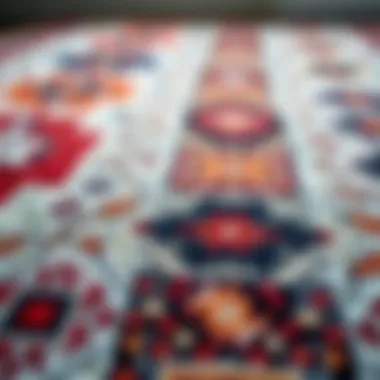
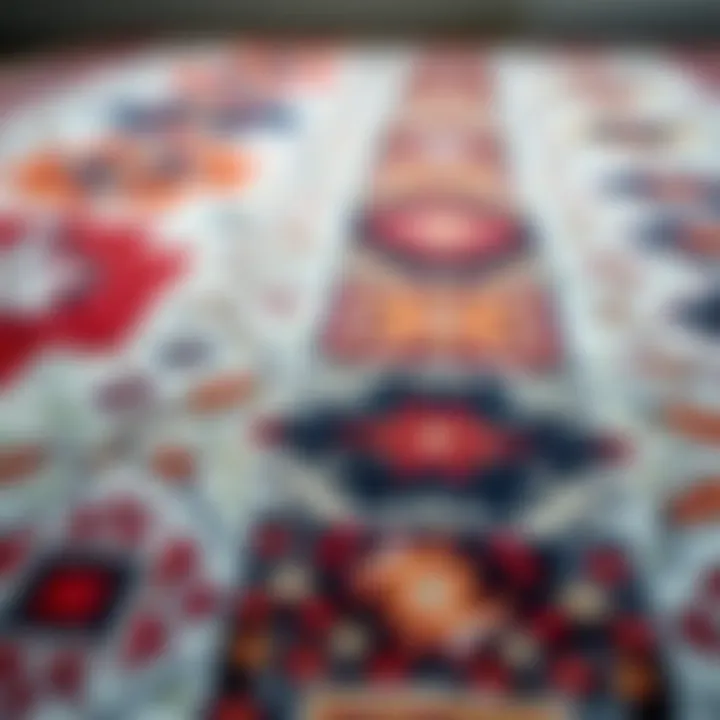
Intro
As we step into the realm of Safavieh Kilim rugs, one quickly notices a tapestry of rich colors and intricate patterns that have a story to tell. These high-quality rugs are not merely decorative pieces but rather embodiments of culture and craftsmanship which have traversed time. In this exploration, we will navigate through their historical significance, artistry, and the modern day applications. This article aims to provide a comprehensive look into how you can seamlessly incorporate these rugs into your living spaces, whilst appreciating the sheer dedication of artisans behind every woven fiber.
Furniture Design Trends
The evolution of interior design has opened the door for distinct styles and creative expressions. Safavieh Kilim rugs have naturally found a cozy place amid these trends, embracing both tradition and contemporary flair.
Current Trends in Furniture Design
- Mixed Materials: A growing trend involves mixing various textures and materials. Safavieh Kilim rugs add a woven touch that contrasts beautifully against sleek surfaces like glass and metal.
- Natural Elements: With a drift towards sustainability, natural fibers and earthy tones are right in vogue. The organic motifs in Kilim rugs complement wooden furniture, creating a harmonious atmosphere.
- Eclectic Styles: Diverse styles have become mainstream. Kilim rugs, with their vibrant patterns, can serve as a central piece that brings together an eclectic mix of furniture.
Influential Designers to Follow
When diving deeper into the world of furniture design, it’s helpful to keep an eye on designers known for innovative concepts:
- Kelly Wearstler: Renowned for bold designs that meld different styles.
- Joanna Gaines: A champion of modern farmhouse aesthetics which can be dynamically paired with Kilim.
- Isabelle McAllister: Known for her use of textiles to enhance decor.
Practical Tips for Furniture Selection
When selecting furniture that works well with Safavieh Kilim rugs, it's key to bear in mind certain practical aspects.
Choosing the Right Materials
Pay close attention to material choices; this can significantly impact both function and aesthetics.
- Cotton and Linen: These fabrics are both breathable and durable, giving that perfect match with the vibrant Kilim texture.
- Leather: Adds a luxe feel while standing in stark contrast to the softness of rugs.
Maximizing Space with Smart Furniture Choices
Consider the layout of your space to make it feel open without sacrificing style. Here are a few strategies:
- Multi-Functional Pieces: Look for ottomans or center tables that can serve different purposes while fitting snugly on the rug.
- Scaled Proportions: Choose furniture that complements the size of your Kilim rug, ensuring that neither overshadows the other.
Incorporating Safavieh Kilim rugs into modern decor not only elevates your home aesthetic but also pays homage to a rich tradition of artistry.
By understanding the intersection of current trends and practical furniture selection, one can create a living space that is both welcoming and impressive. As we further explore the nuances of Safavieh Kilim rugs, we open up a treasure trove of possibilities that not only enrich the ambiance but also tell a timeless story.
Prolusion to Safavieh Kilim Rugs
The world of rugs is a tapestry of cultures, weaving together stories and artistry that span generations. Among these, Safavieh Kilim rugs stand out, offering a unique blend of heritage and innovation. In this section, we’ll explore the significance of Safavieh Kilim rugs, diving into their origins, craftsmanship, and their place within modern interior design.
Safavieh, a name synonymous with quality, has long been a beacon in the rug market, recognized for its ability to marry traditional techniques with contemporary aesthetics. With their flat weave style, Kilim rugs are distinct, not just in appearance but also in the intricate storytelling that each piece embodies. These rugs not only add warmth and comfort to a home but also offer a glimpse into the rich cultural narratives from which they originate.
The importance of understanding Safavieh Kilim rugs cannot be overstated. Here are several factors that highlight their relevance:
- Aesthetic Versatility: From modern minimalism to bohemian chic, Kilim rugs can complement a wide array of interior styles, making them a favored choice among homeowners and decorators.
- Sustainable Craftsmanship: Crafted using traditional techniques, these rugs are often made from natural fibers, reflecting a commitment to sustainability. This resonates with a growing demographic that values ethical consumption in their decor choices.
- Cultural Heritage: Each rug encapsulates a piece of history. The patterns and colors used can be heavily symbolic, reflecting the identities and values of the cultures they represent.
Moreover, understanding the nuances in care, selection, and placement makes a significant difference in how these rugs influence living spaces. Choosing the right rug involves more than just aesthetics—considerations such as texture, size, and color harmony can make or break the overall design scheme.
In summary, Safavieh Kilim rugs are not merely decorative items; they are functional art pieces that serve as conversation starters. As we unravel the different aspects of these rugs in the following sections, we’ll gain a deeper appreciation for their artistic styles, craftsmanship, and their role in contemporary decor. Embracing Safavieh Kilim rugs in a home signifies an embrace of beauty, tradition, and a story well told.
Historical Context
The historical context of Safavieh Kilim rugs provides a rich tapestry that goes beyond their mere aesthetic appeal. It lays the groundwork for understanding the evolution of the craft, offering insight into the various influences that shaped their design and use. Recognizing this context is essential for anyone keen on appreciating these rugs not only as decor items but as pieces of cultural heritage.
Origins of Kilim Rugs
Kilim rugs have roots that stretch back several centuries, primarily across regions such as Turkey, Persia, and the Balkans. The word 'Kilim' itself refers to a flat tapestry-woven rug or wall hanging, typically devoid of pile, which sets it apart from other rug types. This method of weaving originated out of necessity. Nomadic tribes, who roamed the steppes, needed a durable yet lightweight floor covering, and thus the artistry of Kilim weaving was born.
These rugs often tell stories through their motifs and colors. For instance, designs can reflect the surroundings, encompassing elements like the azure blue of the sky or the rich browns of the earth. The transmission of techniques and styles between cultures further enriched Kilim design. Influences from neighboring civilizations added layers of complexity and depth to these weavings. The unique combination of practical function and artistic expression in Kilim rugs makes them significant historically.
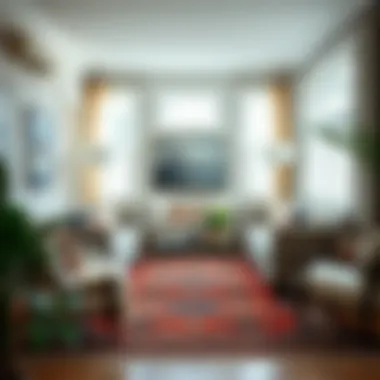
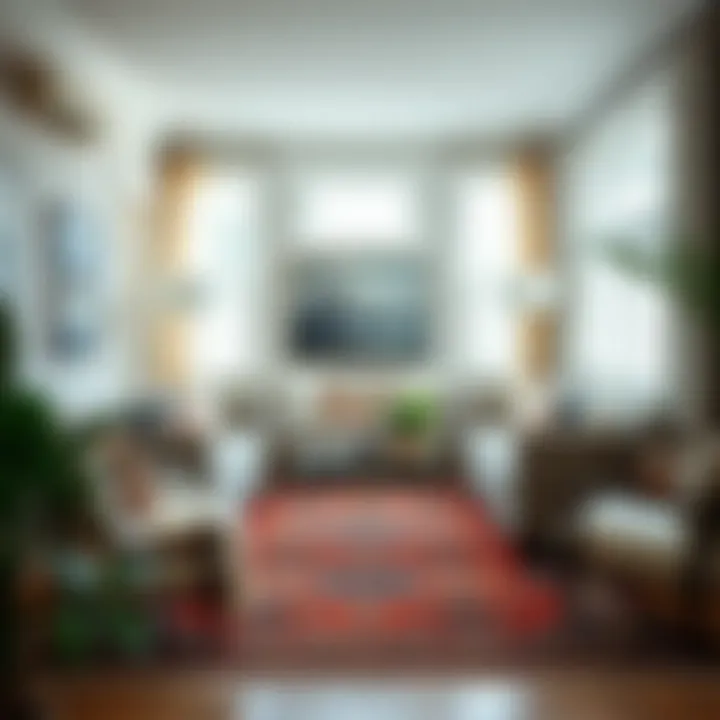
Cultural Significance
The cultural significance of Kilim rugs is undeniably profound. They are not just decorative items; they encapsulate traditions and heritage that span generations. In many cultures, Kilims are passed down as family heirlooms, symbolizing a deep connection to one’s ancestry. Beyond aesthetics, these rugs serve as a social fabric, often used in ceremonial occasions such as weddings or religious events.
Moreover, the patterns woven into these rugs hold specific meanings. For example, certain geometric shapes might represent fertility or prosperity. By understanding these symbols, we gain insight into the values and beliefs of the communities that crafted them.
A fascinating aspect of Kilim rugs is the role they played in trade and commerce. Historically, they were often used as barter items, facilitating exchanges between various cultures. This just highlights their integral role not just in homes but in the economies and interactions of different societies.
In essence, the historical and cultural significance of Safavieh Kilim rugs provides us with a glimpse into the intricate relationship between art, culture, and history. Understanding these factors not only enriches our appreciation of these beautiful textiles but also helps maintain the narrative around them for future generations.
"Kilims are the essence of stories told through threads, each piece a quilt of history that binds us to the times before."
The journey of Kilim rugs from nomadic necessity to contemporary interiors showcases their versatility and timeless appeal, making them indispensable in both design and cultural conversations.
Artistic Styles of Safavieh Kilim Rugs
Artistic styles in Safavieh Kilim rugs play a crucial role in how these pieces are perceived and utilized within different spaces. They are not just decorative elements; they are expressions of cultural heritage and craftsmanship. Understanding these styles can guide interior designers, homeowners, and decorators in selecting the right rug that speaks to their aesthetic and functional needs.
The variety of artistic styles can influence not only the overall look of a space but also the emotional atmosphere it conveys. Different patterns and motifs can evoke distinct feelings. Thus, familiarity with these styles can empower one to choose rugs that enhance the room’s ambiance.
Moreover, the artistic attributes often reflect the regions from which the Kilim rugs originate. Therefore, researching and recognizing these details enriches the experience of owning such rugs. Each piece is not merely a textile; it’s a story woven through generations.
Geometric Patterns
Geometric patterns in Safavieh Kilim rugs are a hallmark of their artistic expression. These designs often feature a mix of sharp angles, lines, and symmetries, portraying a sense of order and harmony. This layout can create visual intrigue, making the rug not just a floor covering but a striking statement in any room.
The appeal of geometric patterns lies in their versatility; they can fit seamlessly into both modern and traditional interiors. For instance, a bold geometric Kilim can serve as a focal point in a minimalist space, providing a stunning contrast while still maintaining a clean aesthetic.
When selecting such a rug, consider the color palette of your room. Neutral hues in geometric designs can evoke a calming atmosphere, while vibrant colors can inject energy and vibrancy. Moreover, geometric patterns can build visual pathways within your space, guiding the eye and influencing the flow of movement.
An example of how these rugs fit into design can be found in open-concept living areas. A Kilim with a striking geometric pattern can delineate spaces, marking the transition from one area to another while enriching the overall decor.
Floral Designs
Floral designs in Safavieh Kilim rugs add a layer of warmth and organic beauty. These patterns often reflect the natural world, encapsulating various flora through intricate motifs and soft curves. The presence of flower-inspired designs can soften a space, introducing a sense of tranquility and comfort.
In many cultures, floral designs carry deep meanings and symbolisms, contributing layers of storytelling to the rugs. For example, a floral Kilim may express themes of growth, renewal, or even celebration, depending on the specific flowers depicted. This can resonate well with homeowners looking to infuse their spaces with thoughtful aesthetics.
Floral patterns also provide excellent opportunities for enhancing color schemes. A rug showcasing bold florals can become a breathtaking centerpiece in a room adorned with subtler tones, effectively adding life to the environment.
In living areas or bedrooms, floral Kilim rugs can create an inviting atmosphere, making spaces feel homely and welcoming. When choosing a floral Kilim, it’s wise to consider the existing decor—mixing and matching with other patterns can yield delightful results if done judiciously.
In summary, the artistic styles of Safavieh Kilim rugs, particularly geometric and floral patterns, serve as pivotal elements in interior design. They not only elevate the aesthetic quality of a space but also invite deeper engagement with the cultural narratives behind each design.
Craftsmanship in Kilim Rugs
The craftsmanship involved in creating Safavieh Kilim rugs is what transforms these textiles from mere floor coverings into statements of culture and artistry. A keen eye for detail and an immense amount of skill go into every rug, which is important for several reasons. First, this craftsmanship ensures not just quality and durability but also encapsulates the rich history and heritage that these rugs represent. Understanding the intricate processes involved in their production allows collectors, interior designers, homeowners, and decorators to appreciate the depth of effort and emotion intertwined in each piece.
Materials Used
The materials selected for crafting Kilim rugs play a pivotal role in determining their final character and utility. Traditionally, wool has been favored due to its resilience and natural insulating properties. However, more recent adaptations have introduced a variety of fibers and dyes, each bringing something unique to the table.
- Wool: The backbone of most Kilim rugs, this fiber is soft yet strong, able to withstand foot traffic while naturally repelling stains and dirt. The warmth and softness it provides make it a preferred choice for households.
- Cotton: Though less common, cotton is sometimes blended with wool to create lightweight rugs. This material tends to have a different texture, often preferred for specific artistic expressions.
- Natural Dyes: The use of vegetable-based dyes connects Kilim rugs to their environmental roots. The hues obtained through natural processes are often more subtle and varied than synthetic options, lending a charm that cannot be easily replicated.
- Synthetic Fibers: In the modern market, some rugs utilize synthetic fibers. While they can mimic the aesthetics of traditional Kilims, they often lack the authenticity and depth of character found in natural materials.
By using quality materials, artisans ensure that the rugs not only look appealing but also have longevity, making them a worthy investment in home décor.
Weaving Techniques
The techniques employed in weaving Kilim rugs significantly influence their design and texture. These ancient methods are a deeply established part of the crafting process, each with its significance and purpose.
- Flatweaving: Classic Kilim rugs are known for their flatweave design, which involves interweaving the warp and weft without knots. This style showcases the colors and patterns in a vivid manner, emphasizing the tapestry-like quality.
- Tapestry Weaving: Although not exclusive to Kilim rugs, tapestry weaving can be found in some designs. This technique allows for more complex images and patterns, often telling a story or depicting intricate scenes.
- Loom Techniques: Different types of looms, such as vertical or horizontal, can affect the weave's density and texture. Each loom type imposes its own characteristics on the finished product, impacting its weight and flatness.
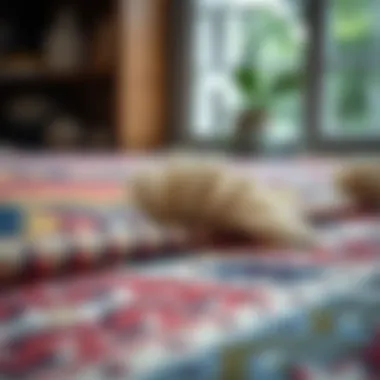
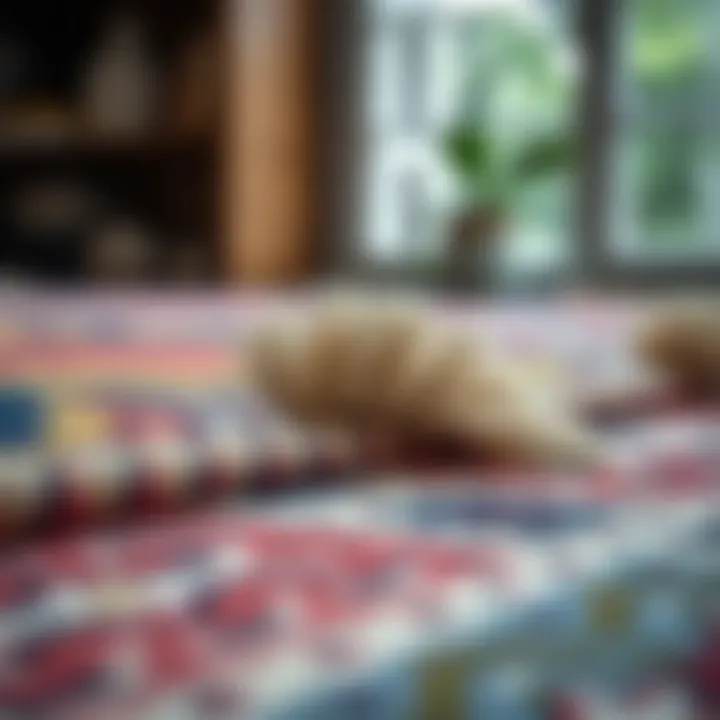
"The tactile experience of a Kilim rug lies not just in its appearance but in the very way it was woven. Each thread tells a story."
Understanding these weaving techniques gives insight into the work involved. It’s fascinating how just a few variations can lead to a plethora of unique designs and textures.
In sum, the craftsmanship of Kilim rugs is a blend of material selection and weaving techniques that speak volumes about culture, tradition, and artistry. Each piece serves as a detailed narrative, reflecting the hands and hearts of the craftsmen who shaped it.
Modern Applications
Modern applications of Safavieh Kilim rugs are a fascinating blend of tradition and contemporary style. As homeowners increasingly seek unique pieces that reflect their personality, these rugs offer both a functional and artistic element to any home. The patterns, colors, and textures of Kilim rugs allow for much versatility in home decor, making them coveted items for interior designers and homeowners alike.
Integrating Kilim rugs into contemporary decor is about more than mere aesthetics; it's about creating a space that resonates with warmth and character. The flat-weave style of these rugs complements a variety of furniture types, from minimalist to eclectic. The significant benefit here lies in their ability to soften otherwise stark or modern spaces that might feel too sterile or cold. Picture a sleek, glass coffee table positioned atop a vibrant, geometrically patterned Kilim rug; suddenly, the entire room feels more inviting.
Integration into Contemporary Decor
The process of integrating Safavieh Kilim rugs into modern interiors requires an understanding of color palettes and design principles. Choosing the right rug can serve as a centerpiece that ties the room together.
- Start by assessing the color scheme of your space. Kilim rugs often feature striking colors and bold patterns that can either contrast with or compliment existing elements. For example, a Kilim rug with deep reds and greens can seamlessly blend into a room decorated with similar earthy tones.
- Don’t shy away from mixing patterns. This approach can create a visually stimulating atmosphere. Combining patterned wallpapers or throws with a Kilim rug can give your space an eclectic vibe that feels carefully curated rather than chaotic.
- Consider the scale of the rug. A large Kilim can anchor a dining area or a living room, while smaller versions can delineate cozy reading nooks or hallway spaces, providing functionality alongside style.
When you allow your interior to be guided by a Kilim rug, you furnish the room with a story, a tradition that can be traced back for centuries.
Versatility in Various Spaces
One of the truly remarkable aspects of Safavieh Kilim rugs is their versatility. Beyond living rooms and bedrooms, these rugs can enhance several different areas within a home. Consider the following:
- Entryways: Kilim rugs can create an inviting first impression. A well-placed rug can mitigate dirt from shoes while adding charm to what might otherwise be a standard, utilitarian space.
- Kitchens: Although it might seem unconventional, a flat-weave Kilim can add character to a kitchen, particularly if you have a spacious dining area attached. This can be particularly effective if you have rustic or farmhouse-style decor.
- Home Offices: A Kilim rug can inject personality into a workspace, making it feel less sterile and more welcoming. This helps in blending work and comfort, which can boost motivation.
The unique patterns of Safavieh Kilim rugs can act as conversation starters, making them invaluable not just for decor, but as an integral part of the atmosphere in a home.
In essence, the modern application of Kilim rugs transcends mere decoration. It involves thoughtful layering, strategic placement, and an appreciation for the enduring craftsmanship that brings these pieces to life. Their ability to fit various styles while providing a canvas for creativity lets you make a statement without saying a word.
Selecting the Right Safavieh Kilim Rug
When it comes to bringing a touch of elegance and culture into your living space, selecting the right Safavieh Kilim rug is paramount. This decision goes beyond mere aesthetics, influencing not only the visual flair of a room but also the overall ambiance. The richness in color and pattern can transform a dull area into a vibrant, warm haven. In this section, we’ll delve deep into the specifics of choosing a rug that complements your style, meets your needs, and stands the test of time.
Assessing Quality
The quality of a Safavieh Kilim rug can make a significant difference in its durability and overall look. When assessing quality, consider the following aspects:
- Material Composition: Authentic Kilim rugs typically use natural fibers like wool or cotton. Wool is generally preferred for its resilience and softness. Synthetic materials may be less expensive but will lack the charm and durability.
- Weave Tightness: A tightly woven rug signifies a higher quality. Run your fingers over the weave; it should feel firm and taut. If the weave seems loose or uneven, it signals a poor-quality product.
- Consistency of Patterns: High-quality rugs maintain pattern consistency throughout. Gaps or mismatched designs may indicate a rush job, one which could result in a rug that doesn’t last long.
- Fringing: Look for hand-finished edges and fringe. Machine-made rugs often exhibit uneven fringing, whereas handwoven pieces display meticulous attention to detail.
Taking these factors into consideration might require some time and patience, but it’ll pay off when you’re enjoying a beautiful Kilim rug in your home for years to come.
Size and Color Considerations
Choosing the appropriate size and color for your Safavieh Kilim rug is just as critical as its quality. These factors will influence how the rug fits into your existing decor and how it feels within the space.
- Size Matters: Measure your space accurately. As a rule of thumb, a rug should fit under the furniture to create a cohesive look. For example, in a living room, consider a rug that accommodates the front legs of your sofa and chairs. If unsure, err on the side of larger rather than smaller; a larger rug can define an area better without making it feel cramped.
- Choosing Color: The color palette in your rug should harmonize with existing colors in your home. For lively, bright rooms, consider a rug with bold designs that can draw attention. However, if your decor is more subtle, a muted kilim rug can provide a great contrast without overpowering.
- Pattern Impact: Geometric patterns can lend a modern feel, whereas floral designs often evoke a traditional aesthetic. Think about the mood you want to create and select accordingly.
Utilizing these guidelines will help ensure that the rug not only fits but also enhances the overall charm of your home. With a little thought and effort, selecting the right Safavieh Kilim rug can be an enriching experience, offering both beauty and function.
Maintaining Kilim Rugs
Maintaining Kilim rugs is essential for preserving their beauty and functionality, especially considering their unique construction and the vibrant patterns they showcase. An integral part of home decor, these rugs are not only decorative but also serve practical purposes. Given their intricate weaving and often natural materials, proper maintenance can greatly prolong their lifespan and maintain their aesthetic appeal.
For homeowners, interior designers, and decorators, understanding how to care for these rugs will ensure that they continue to enrich spaces for years to come. The benefits of regular maintenance extend beyond mere aesthetics; they include protection from environmental hazards, such as excess moisture or UV damage, which can compromise the integrity of the fibers. With that said, let’s delve into two key areas of maintaining Kilim rugs: effective cleaning techniques and strategies to prevent wear and damage.
Cleaning Techniques
Keeping Kilim rugs clean requires a gentle approach, tailored to the materials used in their construction. Here are some effective cleaning techniques to consider:
- Regular Vacuuming: Use a vacuum cleaner with a beater bar turned off. Go over the rug in the direction of the fiber to avoid pulling threads. Regular vacuuming, at least once a week, helps remove dust and dirt without damaging the fibers.
- Spot Cleaning: For spills, act quickly. Blot the stain gently with a clean cloth, avoiding rubbing it in further. A mixture of mild soap and water can be dabbed on with a soft cloth and then blotted dry.
- Professional Cleaning: Every few years, consider taking the rug to a professional cleaner experienced with Kilim rugs. They can perform a deep cleaning that guards against damage while restoring the rug to its original luster.
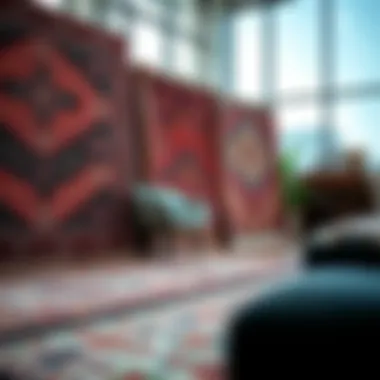
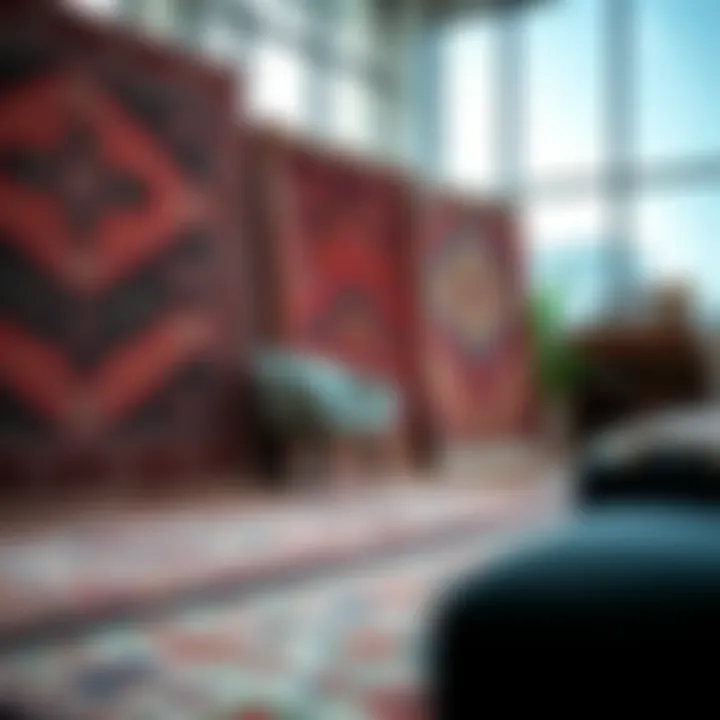
"To ensure a Kilim rug ages gracefully, start by implementing simple care habits that keep grime at bay."
Preventing Wear and Damage
Preventing wear and damage is equally crucial in maintaining the integrity of Kilim rugs. Here are some strategies to safeguard your investment in these beautiful pieces:
- Rotate Regularly: To ensure even wear, rotate your Kilim rug every six months. This is particularly important in high-traffic areas where certain patterns may outlast others.
- Use a Rug Pad: A rug pad not only prevents slipping but also provides cushioning that absorbs impact, reducing wear on the fibers.
- Avoid Direct Sunlight: Ultraviolet rays can cause colors to fade over time. Positioning rugs away from direct sunlight can help preserve their vibrant hues.
- Address Damage Promptly: If you notice any fraying or wear, deal with it immediately. Sewing loose threads or taking the rug to a professional can prevent minor issues from escalating.
In summary, understanding how to maintain Kilim rugs not only protects their beauty but also reinforces their role in elevating interior spaces. Regular cleaning and preventive care can keep them as a stunning focal point of your home for many years, making them a wise investment for any discerning decorator or homeowner.
Cultural Influences on Design
Cultural influences play a pivotal role in the design of Safavieh Kilim rugs. These rugs are not merely decorative; they tell stories rich in tradition, heritage, and the intricacies of the regions they originate from. Understanding these influences allows us to appreciate the craftsmanship behind each piece, as well as the deeper connections woven into their patterns and colors.
Regional Variations
The variety in regional styles is one of the most striking aspects of Kilim rugs. Each area that produces these rugs has distinct traits influenced by both geography and the local culture. For instance, Persian Kilim rugs often feature intricate motifs and vibrant colors that reflect the rich tapestry of Persian art. On the other hand, Turkish designs tend to incorporate bolder geometric shapes and earth-toned palettes that resonate with the nomadic tribes' environment.
Additionally, one can see how social structures and customs are intertwined in the weavings. For example, communities with a history of nomadic lifestyles might favor practical, lightweight designs, while settled populations might produce more ornate and heavier rugs. This difference is critical for interior designers and decorators, as it allows them to select rugs that not only fit aesthetic needs but also resonate with the cultural narrative they want to convey in a space.
Symbolism in Patterns
Delving into the symbolism behind the patterns in Safavieh Kilim rugs reveals another layer of meaning. Many of the designs reflect the traditions of storytelling and spirituality. Common symbols include:
- Animals: Representing strength or fertility, designs may include stylized depictions of local fauna, which hold significance in the culture.
- Geometric Shapes: Lines and forms may depict elements of nature, showcasing the landscape from which the artisans draw inspiration.
- Colors: Each color carries its own meaning, such as red symbolizing joy or blue representing protection.
The designs are not random; each stroke of the weaver’s hand is imbued with meaning that speaks to the culture’s beliefs and values. Recognizing these elements allows one to appreciate not just the visual appeal of Safavieh Kilim rugs but also the story they narrate.
Integrating these culturally significant designs into contemporary settings can create spaces that echo with history while maintaining modern aesthetics. Interior designers often harness this cultural depth, fostering an enriching dialogue between past and present in the environments they curate. The allure of Safavieh Kilim rugs lies not only in their beauty but also in the myriad of cultural pathways they open up, making them versatile pieces for any home.
The Future of Safavieh Kilim Rugs
As we look forward, the path for Safavieh Kilim rugs seems as intricate and vibrant as the patterns woven into their very fabric. The future of these celebrated textiles is not just a tale of tradition but a narrative accented by innovation. Understanding the direction in which these rugs are headed helps both enthusiasts and decorators to make informed choices that honor the past while embracing modernity. Here are some crucial aspects that illuminate the upcoming trends in this cherished textile form.
Trends in Design
The design landscape for Kilim rugs is quickly evolving. While the time-honored patterns remain in demand, there's a noticeable shift towards blending these traditional styles with contemporary design aesthetics. Here’s a closer look at what this might entail:
- Mixing Old with New: Designers are increasingly layering Kilim rugs with modern furnishings, creating a juxtaposition of textures and styles that brings fresh life to living spaces.
- Bold Colors: Moving forward, we can expect to see brighter hues and bolder combinations in Kilim patterns. Expect traditional earth tones to share the stage with lively colors, allowing rugs to stand out as statement pieces in any room.
- Geometric Emphasis: The geometric style, already favored in modern design, is likely to continue its rise in popularity. Rug creators may experiment with shapes to create more abstract interpretations of classic Kilim designs.
- Functional Art: As homes adapt to multifunctional spaces, the concept of rugs that serve as both decor and utility will gain traction. Expect to see thinner, lightweight Kilim options that are easy to move and reconfigure.
With these trends, the Safavieh Kilim rug may transition from a simple flooring accessory to an essential design element that can transform an entire room.
Sustainability and Lexicon Adaptation
Sustainability is on the minds of many consumers today. The future of Safavieh Kilim rugs is closely intertwined with eco-friendly practices. Natural fibers such as wool and cotton, characteristic of traditional Kilims, showcase a sustainable approach to textile production. Things to focus on include:
- Eco-conscious Materials: As awareness about environmental impact grows, manufacturers are likely to place a higher emphasis on sourcing organic and sustainably-produced materials for Kilim rugs.
- Durability: By shifting towards more durable weaving techniques, the longevity of these rugs can be enhanced, reducing the need for frequent replacements. This increases their sustainability footprint as well.
- Transparency in Production: A future shift will see a demand for transparency about the manufacturing process. Consumers will want to know how and where their rugs are produced, which will influence which brands thrive.
Furthermore, the lexicon around Kilim rugs is adapting. Terms like “sustainable textiles” and “eco-friendly materials” will likely become commonplace as more brands align themselves with these values. The conversation around the art of Kilim rugs is evolving, showcasing not only their aesthetic appeal but also their potential for a greener future.
"In every weaved strand, a story is told; in every design, a heartbeat of culture resonates. The future of Kilim rugs rests on honoring this legacy while moving toward an eco-conscious tomorrow."
Through these considerations, the future of Safavieh Kilim rugs presents an exciting narrative. As innovation continues to blend with tradition and sustainability becomes a guiding principle, these rugs will not only adorn spaces but also tell stories of our evolving design ethos. For more insights, you can visit resources like Wikipedia or Britannica that delve deeper into the cultural significance and artistic styles of these unique textiles.
The End
In wrapping up our exploration of Safavieh Kilim rugs, it becomes clear that these artisanal pieces extend far beyond mere decorative elements in a home. Their intricate designs, intertwined with centuries of cultural history, showcase a stunning blend of craftsmanship and aesthetic appeal. The significance of Kilim rugs lies not just in their beauty, but also in their ability to act as narrators of a rich heritage, speaking to the artistry of the weavers who poured their hearts into these textiles.
For interior designers and homeowners alike, understanding the essence of Safavieh Kilim rugs opens doors to endless decorative possibilities. These rugs can serve as a striking focal point or an understated complement, easily fitting into various design styles.
Key Benefits and Considerations
- Cultural Richness: Each rug tells a story, representing the unique traditions of the regions from which they originate. Incorporating one into your space adds depth and meaning, an aspect often overlooked in contemporary decor.
- Versatility in Design: Their adaptable nature means they can transition seamlessly from modern apartments to traditional homes. The geometric patterns and vibrant colors can breathe life into any room, enhancing the overall ambiance.
- Practical Considerations: While beauty is paramount, the durability and ease of maintenance of these rugs should not be overlooked. With the right care, they can endure the everyday hustle and bustle, making them a worthy investment for any homeowner.
"A rug is not just a piece of decor; it is a tapestry of stories woven with love."
As we move forward, let the insights shared here empower your decisions, ensuring that the rugs chosen are not just furnishings, but integral elements of your living environment.



